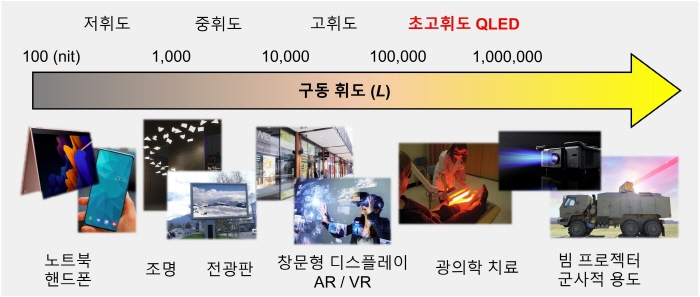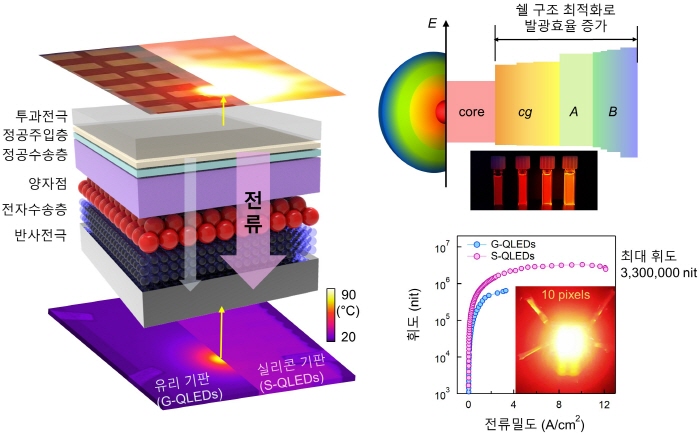loaction
공대뉴스광장
A Joint Research Team of SNU Professor Jeonghun Kwak - Sungkyunkwan University Professor Jaehoon Lim Develop Red QLED With Ultra-High Luminance
-
작성자
관리자
-
등록일
2021.11.30
-
조회수
114
A Joint Research Team of SNU Professor Jeonghun Kwak - Sungkyunkwan University Professor Jaehoon Lim Develop Red QLED With Ultra-High Luminance
- Multi-faceted approaches for quantum dot materials and device structures withstanding high current
- Various applications of self-luminous QLEDs as well as displays are expected

▲ (From left) Professor Jeonghun Kwak of the Seoul National University Department of Electrical and Computer Engineering, Professor Jaehoon Lim of Sungkyunkwan University, Ph.D student Taesoo Lee of the Seoul National University Department of Electrical and Computer Engineering, Graduate Research Student Byongjae Kimof Sungkyunkwan University
Seoul National University's College of Engineering (Dean Byoungho Lee) announced on November 16 that a joint research team led by Professor Jeonghun Kwak of the Department of Electrical and Computer Engineering and Professor Jaehoon Lim of Sungkyunkwan University (First authors are Tae-Soo Lee and Byongjae Kim) has developed a quantum dot material and device structure that can be operated stably even under high luminance conditions and a ultra-bright red QLED that emits up to 3.3 million nits of light and operates stably even at high luminance of tens of thousands of nits.
Currently, the use of self-luminous QLED is limited to low- and medium-brightness (hundreds to thousands of nits) displays such as TVs, laptops, and mobile phones. In order for QLEDs to be used in various fields such as AR/VR devices, outdoor displays, and lighting and phototherapy devices, high-brightness conditions of tens of thousands of nits or more are required but QLED devices so far have not operated at high luminance or have shown very low device efficiency and stability.
In order to achieve high luminance, a high current must be applied to the QLED. However, it has been difficult to fabricate high-brightness QLEDs due to accelerated device degradation due to Joule heat generation caused by high current and reduced luminous efficiency of quantum dots due to the increase in non-emission Auger recombination due to the generation of multi-excitons.

▲ Possible commercialization field of QLED according to driving luminance
The joint research team developed a material that can maintain luminous efficiency even at high currents by effectively suppressing non-luminescent Auger recombination that occurs at high currents by precisely controlling the structure of the shell constituting the quantum dots.
In addition, by using a silicon substrate, which has high thermal conductivity, deterioration of the device due to Joule heat was suppressed while the luminance was increased by optimizing the front light emitting structure to increase the light extraction efficiency. Finally, by controlling the number of quantum dots inside the emission layer, the formation of multi-excitons with low luminous efficiency was minimized.

▲ Device, material structure and performance of ultra-bright QLED
QLED manufactured through a multifaceted approach from material to device exhibited a maximum luminance of 3.3 million nits (optical output 50 mW) and a current efficiency of 75.6 cd/A, and the expected half-life at the initial luminance of 100 nits reaches 125,000,000 hours (about 14,269). This is the highest luminance, efficiency, and lifespan among QLEDs announced so far.
The results of this study are expected to contribute to practical research on QLED displays and be applicable to AR/VR devices or outdoor displays that require high luminance. In addition, it is expected that the application range of self-luminous QLED will be expanded to not only displays but also in the fields of lighting, laser, photobiomodulation therapy, etc., so that it can be applied to various light-related industries.

▲ Ultra-bright QLED Utilization Applications
Meanwhile, the results of this study were published online on October 27 in the journal 'Advanced Materials', one of the most prestigious journals in the field of materials, nanotechnology and science and was carried out with the support of the Ministry of Trade, Industry and Energy's Technology Innovation Project, Seoul National University's Creative Researcher Project, and from the Ministry of Science, ICT and Future Planning.
담당부서기획협력실
전화번호880-9148